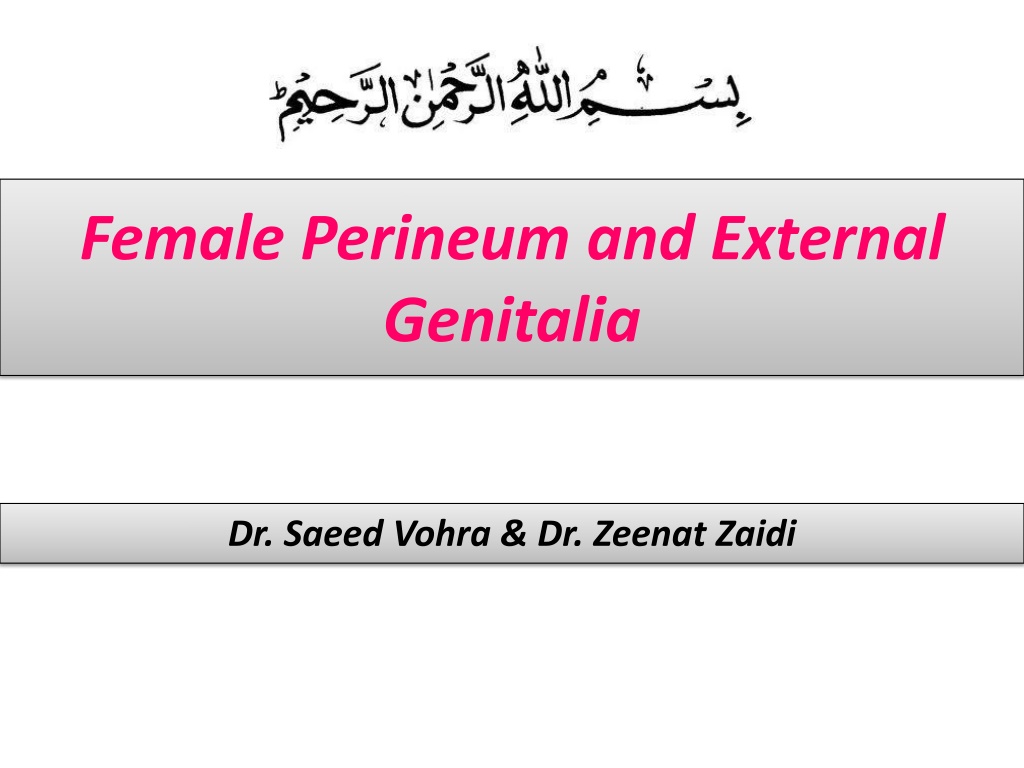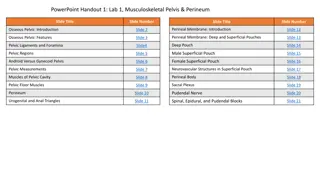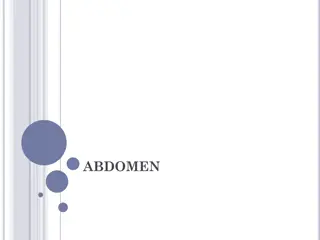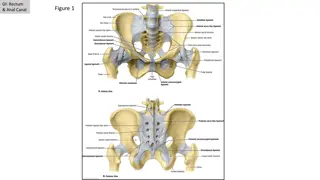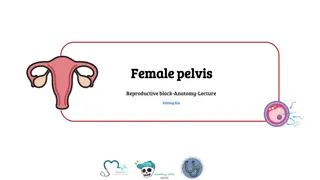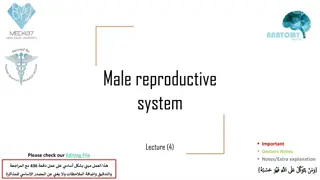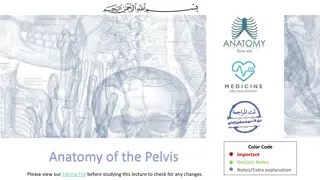Understanding Female Perineum and External Genitalia Anatomy
Explore the detailed anatomy of the female perineum and external genitalia, including boundaries, division into two triangles, structures, and functions. Learn about the perineal body, anococcygeal body, and the innervation, blood supply, and lymphatic drainage of the perineum. Enhance your knowledge of the urogenital triangle, anal triangle, and the role of the perineum in female visceral support.
Download Presentation

Please find below an Image/Link to download the presentation.
The content on the website is provided AS IS for your information and personal use only. It may not be sold, licensed, or shared on other websites without obtaining consent from the author. Download presentation by click this link. If you encounter any issues during the download, it is possible that the publisher has removed the file from their server.
E N D
Presentation Transcript
Female Perineum and External Genitalia Dr. Saeed Vohra & Dr. Zeenat Zaidi
OBJECTIVES At the end of the lecture, the student should be able to describe the: Boundaries of the perineum. Division of perineum into two triangles. Boundaries & Contents of anal & urogenital triangles. Lower part of Anal canal. Boundaries & contents of Ischiorectal fossa. Innervation, Blood supply and lymphatic drainage of perineum.
Perineum Perineum is the region of the body below the pelvic diaphragm It is a diamond shaped area between the thighs Boundaries: Anteriorly Mons pubis Laterally Medial surfaces of the thighs Posteriorly Intergluteal folds Contents: Lower ends of urethra, vagina & anal canal External genitalia Perineal body & Anococcygeal body
Perineal Body Perineal body is an irregular fibromuscular mass of variable size and consistency, located at midpoint of the line between the ischial tuberosities Lies in the subcutaneous tissue, posterior to vaginal vestibule and anterior to the anal canal & anus Forms the central point of the perineum & blends anteriorly with the perineal membrane Function: Gives attachment to perineal muscles Plays an important role in visceral support especially in female
Anococcygeal Body The anococcygeal body is a complex musculotendinous structure Situated between the anterior aspect of the coccyx and the posterior wall of the anorectal canal Receives insertion of fibers of levator ani muscle
Boundaries & Division of Perineum Boundaries: Its bony boundaries are: Anterior: Symphysis pubis. Posterior: Coccyx. Lateral: Ischiopubic rami, ischial tuberosities & sacrotuberous ligament. Division: By an imaginary line passing through two ischial tuberosities, it is divided into: Urogenital triangle anteriorly. Anal triangle posteriorly.
Urogenital Triangle Boundaries : Anteriorly : Symphysis pubis Posteriorly : Transverse line passing through the 2 ischial tuberosities. Laterally : Ischiopubic rami & ischial tuberosities. Contents : Lower part of urethra & vagina. External genitalia (vulva).
Urogenital Diaphragm A triangular musculofascial diaphragm located in the anterior part of the perineum Fills in the gap between the pubic arch Composed of: Sphincter urethrae and the deep transverse perineal muscles enclosed within the superior and inferior layers of fascia of the urogenital diaphragm The inferior layer of the fascia is formed by the perineal membrane
Female External Genitalia (Vulva) Mons pubis : a collection of fat overlying the pubes. Labia majora. Labia minora. Clitoris. Vestibule of vagina: The interval between the two labia minora. Vagina & urethra open into the vestibule through urethral orifice anteriorly and vaginal orifice posteriorly.
Fascia of Urogenital Triangle (Perineal Fascia) The perineal fascia is continuous anteriorly with the fascia of abdomen and consists of superficial and deep layers Superficial perineal fascia: consists of: Superficial fatty layer (Camper s fascia) makes up the substance of mons pubis & labia majora and extends into the anal region Deep membranous layer (Colle s fascia ): Does not extend to anal region. Becomes fused with the posterior margin of the perineal membrane Deep perineal fascia invests the muscles in the superficial perineal pouch
Superficial Perineal Pouch It is the space between the deep membranous layer of superficial fascia and the perineal membrane. BOUNDARIES: Inferiorly: membranous layer of superficial fascia. Superiorly: perineal membrane. Laterally: ischiopubic rami
Contents of Superficial Perineal Pouch Bulbs of vestibule: on each side of vaginal orifice. Crura of clitoris. Superficial perineal muscles: Bulbospongiosus muscle, surrounds orifice of vagina and covers vestibular bulb. Ischiocavernosus muscle, covers crus of clitoris on each side. Superficial transverse perineal muscles. Greater vestibular glands: on each side of vaginal orifice. Perineal branch of pudendal nerve supplying muscles & skin.
Deep Perineal Pouch It is a completely closed space deep to the perineal membrane BOUNDARIES: Inferiorly: Inferior fascia of the urogenital diaphragm (Perineal membrane) Superiorly: Superior fascia of the urogenital diaphragm Laterally: Inferior portion of obturator internus facia Coronal section of pelvis
Contents of Deep Perineal Pouch Part of urethra Part of vagina Sphincter urethrae muscle, which is pierced by urethra & vagina. Deep transverse perineal muscles Internal pudendal vessels Dosal nerve of clitoris
Vagina The vagina is a muscular canal that leads from the uterus to the external orifice of the genital canal It measures about 3 in. (8 cm) long. It serves as the excretory duct for the menstrual flow & forms part of the birth canal. The vaginal orifice in a virgin possesses a thin mucosal fold, called the hymen, which is perforated at its center. Arteries: Vaginal artery, a branch of the internal iliac artery Vaginal branch of the uterine artery Veins: drain into the internal iliac veins
Anal Triangle Boundaries: Anteriorly: Transverse line passing through the 2 ischial tuberosities. Posteriorly : coccyx. Laterally : ischial tuberosity & sacrotuberous lig. Contents: Lower part of Anal canal Ano-coccygeal body Ischiorectal fossa on each side
Anal Canal It is about 1.5 in. long, descending from the rectal ampulla to the anus. Relations(In female): Anteriorly: Perineal body, urogenital diaphragm, and lower part of vagina Posteriorly: Anococcygeal body. Laterally: Ischiorectal fossae. Division:Divided into: Upper half: derived from hindgut (endoderm) Lower half: derived from the proctodeum (ectoderm) The two parts have different blood supply, nerve supply and lymphatic draiange.
Anal canal Arterial supply Venous drainage Lymphatic drainage Nerves Upper half Superior rectal artery (continuation of the inferior mesenteric artery) Superior rectal vein drained into the inferior mesenteric vein (portal circulation) Para-rectal nodes drained into inferior mesenteric lymph nodes Visceral motor (sympathetic & parasympathetic) & sensory nerves Lower half Inferior rectal a. (branch of internal pudendal artery) Inferior rectal vein drained into the internal pudendal vein (Systemic circulation) (site of portal-systemic anastomosis) Superficial inguinal lymph nodes Somatic motor & sensory nerves
Ischiorectal Fossa A fascial lined wedge-shaped space on each side of the anal canal. Boundaries: Base: Skin of the perineum. Medial wall: Levator ani & anal canal. Lateral wall: Obturator internus, covered with fascia. Contents: Dense fat. Pudendal nerve & internal pudendal vessels within the pudendal canal Inferior rectal nerve & vessels crossing the fossa to reach anal canal.
Pudendal Canal: A fascial canal formed by obturator fascia, located on the lateral wall of the ischiorectal fossa Contents: Pudendal nerve Internal pudendal vessels
Pudendal Nerve Block Pudendal nerve block is used in providing analgesia for the second stage of labour and to provide anesthesia of the perineum in order to create or repair an episiotomy. Can be done by transvaginally or through perineal approach. Transvaginal method: The needle is passed through the vaginal mucous membrane toward the ischial spine. After the needle is passed through the sacrospinous ligament, the anesthetic solution is injected around the pudendal nerve Perineal method: The ischial tuberosity is palpated subcutaneously through the buttock. The needle is inserted on the medial side of the ischial tuberosity to a depth of about 1 in. (2.5 cm) from the free surface of the tuberosity. The anesthetic is injected around the pudendal nerve. An episiotomy is a surgically planned incision on the perineum and the posterior vaginal wall during second stage of labor to prevent perineal tear.
Thank You & Good Luck
